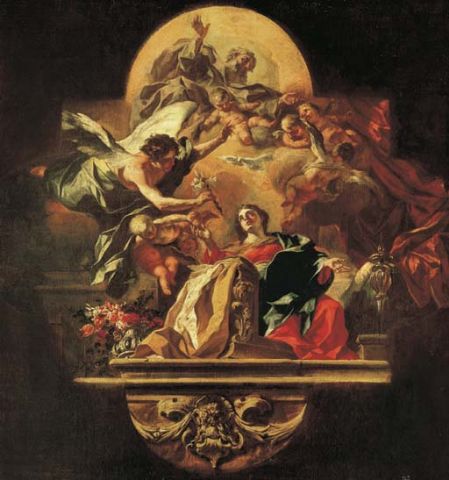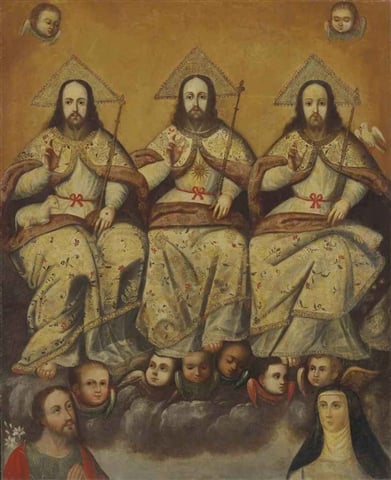Medieval Art of Man on a Throne Holding a Bible and a Sceptor
In the art world, nosotros are used to seeing the same representations of biblical figures. For that reason, we frequently believe that representations of the Holy Trinity follow internationally and unconditionally accustomed conventions: God in Heaven, a dove descending toward Christ, and of course, Jesus, on the cross or being baptized. Merely the complexity of religious history and the multitude of interpretations that arise from a single event led to a wide range of representations of these biblical figures.
This article will provide y'all with an introduction to medieval iconography. Iconography is a science that focuses on the study of images, and medieval iconography is generally idea of as a reference to medieval Catholic iconography. This commodity will focus on the representations of God, the Holy Spirit, the Virgin Mary, and Christ, developed during the Middle Ages (from the fourth century to the 15th century).
Although this article is entitled Introduction to Medieval Iconography, you will notice that the images used are from the Renaissance period. The Renaissance is characterized by a articulate rupture with the Middle Ages in terms of way, medium, and subject field matter, among other things. But in terms of the fashion biblical events were represented, it remained the same and evolved from what was washed during the Middle Ages. Moreover, the paintings I chose are peculiarly helpful in illustrating my points.
The Representation of God:
In the Old Testament, God never appears as a physical person. He is always implied through natural elements, such as a ray of light, burn, wind, etc. This representation is also seen in the New Testament, although far less oftentimes. Some paintings mimic this past representing God through natural elements, or else equally a hand, always the correct, which symbolized ability in the Jewish and Hebraic traditions.
The first evocation of God in physical form occurs in Book Seven of Daniel, verse nine, when he describes God as an old man with a white bear, wearing white dress, seated on a throne, surrounded by calorie-free.

Francesco Solimena, The Annunciation, c.17th–18th centuries, oil on canvas, sold at Christie's New York
In the 14th and 15th centuries, God is normally represented as the Pope or Emperor both on Globe and in Heaven. When represented in this way, God is usually shown with the papal crown, an orb of the Earth, and a religious symbol, such as a cross.
God has also been depicted in a very like manner as the Greek "father of the gods," Zeus. Links betwixt the Christian Church and aboriginal mythology were quite common, due to the fact that it was easier for the population to accept new forms of worship if those forms were based on something they already knew. Indeed, many events in the Christian agenda were set to coincide with major events from pagan civilisation.
The Representation of the Holy Spirit:
In the Erstwhile Testament, the Holy Spirit is portrayed as the spirit present during the Creation. In the New Attestation, the Holy Spirit has an important office in the Annunciation, the baptism, and the Pentecost.
As shown in the painting above, the Holy Spirit is nearly always depicted as a pigeon. The depiction of the Holy Spirit every bit a dove comes from Genesis, and appears again in the text of St. Matthew and St. Marking when they speak about the baptism of Christ.
All the same, the Holy Spirit can likewise appear equally fire, or fifty-fifty as a man, although this is less commonly seen. In the case of the Holy Spirit taking on human class, God, the Holy Spirit, and Christ announced as iii identical men. The Holy Spirit nigh always holds the book, which is 1 of his attributes, Christ appears with the cross, and God with the orb of the Earth.

Bearding, The Holy Trinity, late 17th or early on 18th century (Cuzco Schoolhouse), oil on canvas, sold at Christie'due south New York
The Holy Trinity, seen above, is an instance of Christ, God, and the Holy Spirit represented equally three identical men, identified based on their attributes. On the correct, the dove indicates the Holy Spirit, on the left, the lamb and the stigmata indicate Jesus, and God is in the middle.
For the theme of the Transfiguration of Jesus—the moment when Jesus becomes radiant upon a mountain and speaks with the apparition of Moses and Elijah—the Holy Spirit is often represented as a radiant cloud.
The Holy Spirit is likewise represented with his seven gifts (wisdom, understanding, counsel, cognition, fortitude, piety, and fearfulness of the Lord). These gifts are symbolized by seven medallions, or seven jets of fire nether the pigeon, and serve as a protector of humanity.
The Representation of the Virgin Mary:
Worship of the Virgin Mary began during the very early years of Christianity. Yet, at that place are only a few references to her in the Bible. Almost everything nosotros know most Mary comes from counterfeit texts.
The Church building often treats Mary equally an admission point for Jesus, and much of her importance derives from the significance of that role. More than than half of the references to the Virgin come from legend, stories, or traditions, and we know very niggling about the specific events of her life, and those specifics are often linked to Jesus's life: the Wedlock at Cana, the Crucifixion, the Pentecost, etc. But null is known about her wedding, her youth, or what happens to her during Jesus's public life. And then, after Jesus's decease, the Apocryphal texts depict her supposition.
She is frequently represented with a cape and tunic, often in blue and red. The blue represents her divinity, and is a symbol of sky. The red represents the Earth, or blood, and is symbolic of humanity. Her head is covered every bit a sign of honesty. When her caput is uncovered, it is to underline her virginity. Her image is meant to be ageless, and emphasize her divinity as well as her humanity.
In the early on years of Christianity, Mary often resembled the female icons of older religions, including Isis, who was, among other things, the Ancient Egyptian goddess of maternity.
1 of Mary's attributes is the globe. The world is often symbolic of the Earth, but when depicted in a smaller class, symbolizes a fruit. In this style, Mary came to represent the new Eve, a sign of redemption. St. Thomas said "The fall came through one woman, but redemption came through another."
Mary'due south other attributes include a crown, which she has been associated with since the 12th century, and is emblematic of her position equally "Queen of Heaven."
When her coronation is depicted, she likewise holds a scepter, representative of her role every bit the protector of the Church building (Christ is protector of the Country). A scepter painted with a Fleur-de-lis symbolizes Mary's chastity and purity.
The Representation of Jesus Christ:
Jesus is represented in many ways, some of which do not even involve the homo form.
Indeed, several animals are used in medieval iconography to describe Jesus, or more specifically, 1 of Jesus's characteristics. He can be symbolized by the fish, the dolphin, the eagle, the peacock, the lion, the deer, the ostrich, the pelican, the ant, the phoenix, the ram, and even the unicorn, which was banned during the Counter-Reformation in the 16th century.
The lamb appears in the Old and New Testaments. The lamb is symbolic of the Messiah, which in the Christian tradition is Jesus. The lamb is also associated with sacrifice, which corresponds to Jesus, who was sacrificed and later on resurrected on earth.
The dolphin also symbolizes the expiry and resurrection of Jesus. The dolphin'due south movements, pond above and beneath the surface of the ocean, are symbolic of Jesus's escape from shadow (death) and render to light (life). Moreover, water is besides evocative of the idea of baptism: through baptism, the sinner dies and is reborn in the low-cal of God.
The feathers of the peacock evoke the stars and the galaxy. In early Christian Art, the peacock is linked to the resurrection of Jesus and the immortality of the soul. The peacock sheds his feathers much like the soul leaves the body and embraces immortality. This symbol is oft constitute on headstones.
In terms of his human appearance, two chronological movements established the rules about what Jesus looked like. Initially, because of the influence of the School of Alexandria, Christ was depicted equally a Hellenistic homo, meaning he was represented every bit Apollo, a handsome fellow through whom the divinity shined. Christ was depicted that way until the 4th century.
And then, between the 4th and 6th century, this representation was challenged by the Syriac Schoolhouse, which was linked with the Aristotelian School, and who considered nature to be a reflection of God. According to them, Christ must have looked similar any Christian living in Mesopotamia, but with a clearly divine aura. This is the image we even so have of Jesus today.

Agostino Carracci, Ecce Homo, oil on copper, c.15th–16th centuries, The Art Collection, Inc., Bang-up Neck, NY
This article is based on the class taught past Professor Matilde Azcárate Luxán, Department of Medieval Art, Universidad Complutense, Madrid, Spain.
Follow Artnet News on Facebook:
Want to stay alee of the art earth? Subscribe to our newsletter to get the breaking news, centre-opening interviews, and incisive critical takes that drive the conversation forward.
Source: https://news.artnet.com/market/introduction-to-medieval-iconography-32889
0 Response to "Medieval Art of Man on a Throne Holding a Bible and a Sceptor"
Post a Comment